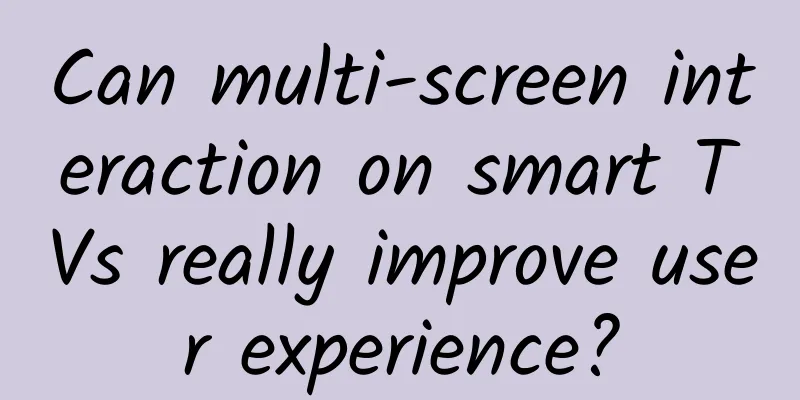Can multi-screen interaction on smart TVs really improve user experience?

|
Multi-screen interaction centered on TV has gradually become popular with the rise of smart TVs. In just a few years, most smart TVs on the market have been equipped with multi-screen interaction functions. However, due to the different interconnection protocols used by manufacturers and the low degree of software optimization, the multi-screen interaction functions of different TVs on the market are also very different. So does the multi-screen interaction of TV terminals now improve the user experience, or is it a useless function? TV, computer and mobile phone are the three platforms that most users come into contact with in their daily life. They have their own characteristics: TV has a large screen and a good viewing experience; computer has many functions and abundant storage space; mobile phone is the most convenient to carry around. Although users have a good viewing experience when watching videos on TV at home, it is far inferior to mobile phones and computers in terms of operation and content resources. The emergence of multi-screen interactive technology aims to integrate the advantages of the three platforms to achieve the best user experience. TV, computer and mobile phone are the three platforms that most users come into contact with in their daily life. They have their own characteristics: TV has a large screen and a good viewing experience; computer has many functions and abundant storage space; mobile phone is the most convenient to carry around. Although users have a good viewing experience when watching videos on TV at home, it is far inferior to mobile phones and computers in terms of operation and content resources. The emergence of multi-screen interactive technology aims to integrate the advantages of the three platforms to achieve the best user experience. Although there are several current multi-screen interactive protocols such as DLNA, WIDI, AIRPLAY, IGRS, Miracast, etc., the final implementation forms can be roughly divided into three categories: the first is small screen to large screen, that is, playing the content of smart terminals such as mobile phones and tablets on large-screen TVs. The second is large screen to small screen, watching the content on the TV on mobile phones and tablets. The third is the mobile phone remote control, which completes various TV controls through mobile phones and tablets. Next, the author will classify and discuss its actual effects from the specific forms of multi-screen interaction. Although there are several current multi-screen interactive protocols such as DLNA, WIDI, AIRPLAY, IGRS, Miracast, etc., the final implementation forms can be roughly divided into three categories: the first is small screen to large screen, that is, playing the content of smart terminals such as mobile phones and tablets on large-screen TVs. The second is large screen to small screen, watching the content on the TV on mobile phones and tablets. The third is the mobile phone remote control, which completes various TV controls through mobile phones and tablets. Next, the author will classify and discuss its actual effects from the specific forms of multi-screen interaction. Pushing from small screen to large screen is the best way Converting from small screen to large screen means projecting the content on small screens such as mobile phones and tablets onto a large-screen TV for playback. Users who have used smart TVs know that compared to the Internet directly accessed by mobile phones and computers, the video resources available for online on-demand TV viewing are really very limited. Many of the latest and hottest film and television content can be found everywhere on the Internet, but it is difficult to find them on TV on-demand platforms. Take the previously popular "The Empress of China" as an example. Most online TV platforms do not support free viewing. Converting from small screen to large screen can greatly enrich the content of TV by directly accessing the Internet through mobile phones and then projecting the content onto a large-screen TV for viewing. Although the small screen to large screen can use the mobile phone as an intermediary, allowing users to watch richer content on TV. However, in actual use, there are many problems with screen switching. Now the small screen to large screen can be specifically divided into two forms: mirroring and push. Mirroring function TV is a large display for mobile phone As the name suggests, mirroring from a small screen to a large screen means copying the content on the mobile phone screen to the TV. The TV is like an oversized display for the mobile phone, which can project all the images on the mobile phone in real time. It just combines the convenience of the large screen of the TV and the mobile phone. Users can watch various online videos on the large screen of the TV, and can also play various smart games on the large screen. However, in the mirroring function, the TV is only used as a second display, and all operations and processing are done by the mobile phone. During the program playback, the phone will directly display the calls or messages received on the big screen. During this period, turning off the phone screen, checking messages, and browsing Moments will cause the TV content to be interrupted. Many people are used to watching TV while chatting on WeChat and browsing Moments, which is a simple thing that has become impossible. Moreover, when mirroring, we are watching a large-screen TV, but the picture of the small-screen mobile phone must also be displayed synchronously, which will quickly consume the battery of the mobile phone. In addition, the picture of the TV mirror is often not as clear as the picture of the mobile phone itself. Advantages : Rich content and easy operation Disadvantages : The phone cannot perform other operations and consumes the phone's battery The stability of the push function needs to be improved Unlike mirroring, in the push function, the mobile phone is only responsible for selecting and controlling the content, while the TV is responsible for obtaining network information, decoding and other functions. During this period, the mobile phone can be completely turned off and can make and receive calls, open applications and perform other operations, which will not affect the playback of TV content, nor will your personal information be displayed on the TV screen. Multi-screen interactive mobile client completes push function Pushing videos from small screens to large screens is definitely a very successful way of multi-screen interaction, but the push of online videos requires the connection between the TV and the mobile client. Although the customized TV client can perfectly support it, the film and television resources it provides are not very rich. The compatibility of third-party video clients with TVs is not high, and even if the push can be completed, it will be very unstable. Advantages: The phone can complete other operations without consuming the phone's power Disadvantages: Low stability, poor software compatibility, insufficient content Large screen to small screen, practical but not often used The purpose of switching from a large screen to a small screen is not to enrich TV content, but to increase the portability of live TV content, and to control smart TVs through touch screens. Although there are abundant online resources, many important competitions and premieres are only broadcast on cable TV. Although some content is also broadcast live on the Internet, the picture quality is not high and there is a long delay. By switching from a large screen to a small screen, we can watch live TV on our mobile phones even when we are cooking in the kitchen, without missing any wonderful moments. Nowadays, smart TVs have more and more functions, but the operation is still basically the same as the previous remote control button control, which is far from the touch screen of mobile phones. With the support of the designated mobile client, the large screen to small screen can not only display the TV screen in real time, but also complete the complex operations of smart TVs by sliding and clicking on the touch screen. Especially for text input, the efficiency of touch screen on mobile phones can be greatly improved.
The significance of switching from a large screen to a small screen lies in watching live TV broadcasts anytime and anywhere, and controlling the TV with a mobile phone touch screen. Especially in the face of the increasingly functional smart TVs, various operations can be completed through the mobile phone display and basic operations, especially for complex operations such as text search, which can greatly improve efficiency. It can be seen that the actual experience of switching from a large screen to a small screen is still quite good, but due to the concept, many users are not used to this operation, but there is no doubt that this multi-screen interactive method can create great convenience for users. Advantages: Watch live broadcast anytime, anywhere, touch screen control is more convenient Disadvantages: fewer supported TVs Mobile phone remote control is convenient but not good Another way of multi-screen interaction is mobile phone remote control. By installing the mobile client or binding WeChat, you can complete various remote control operations on your mobile phone. Under network conditions, you don't need a remote control to control the TV, and you don't have to worry about not being able to find the remote control. In addition, through multi-screen interaction, the mobile phone can also act as a game controller and voice microphone, which is quite rich in functions. Although mobile phones can perform various operations of remote controls through multi-screen interaction, the feel and convenience of using them are not as good as those of remote controls. Nowadays, the screens of mobile phones are relatively large, and it is not very comfortable to hold them with one hand. Remote controls can not only be easily mastered with one hand, but can also be operated blindly after getting familiar with them. Multi-screen interactive remote controls are okay to play with, but it is not realistic to replace remote controls. Advantages: Easy to use and rich in functions Disadvantages: Bad feel Summarize: There is no unified standard for multi-screen interaction. Whether it is technology or form, many companies have their own schools of thought. If we generally talk about the TVs on the market now, the actual experience of multi-screen interaction cannot satisfy people. It is not that there are no good solutions for multi-screen interaction, but that good forms such as push functions and small screen to large screen functions have not been developed and promoted. On the contrary, some imperfect multi-screen interaction forms are becoming more and more popular, which has affected the entire multi-screen interaction. Being able to integrate the advantages of TV, computer, and mobile phone terminals, multi-screen interaction actually has great prospects. Multi-screen interaction cannot improve the user experience, but is only aimed at the current status of smart TV. If functions such as push and small screen to large screen can be popularized, and the stability and compatibility are further improved, I believe that multi-screen interaction can definitely create a new smart experience for users. As a winner of Toutiao's Qingyun Plan and Baijiahao's Bai+ Plan, the 2019 Baidu Digital Author of the Year, the Baijiahao's Most Popular Author in the Technology Field, the 2019 Sogou Technology and Culture Author, and the 2021 Baijiahao Quarterly Influential Creator, he has won many awards, including the 2013 Sohu Best Industry Media Person, the 2015 China New Media Entrepreneurship Competition Beijing Third Place, the 2015 Guangmang Experience Award, the 2015 China New Media Entrepreneurship Competition Finals Third Place, and the 2018 Baidu Dynamic Annual Powerful Celebrity. |
<<: Application of wearable devices: Suguang smart bracelet replaces fingerprint recognition
>>: How Internet vendors are changing the smart terminal market
Recommend
"Can you cure it by taking it at home?" Is azithromycin really that magical?
Review expert: Gu Haitong, deputy chief physician...
Let me briefly talk about how I understand IP marketing in the era of self-media!
What is a long-term marketing method? Event marke...
QQ Groups to be closed? Tencent is furious
Dear users, due to business adjustments, our comp...
Is coffee bad for your heart? Is coffee addictive? Let's learn the truth about the "life-extending magic weapon"
gossip Drinking a cup of coffee has become a ritu...
Foxconn Chairman: Mass production of electric vehicles in the United States in 2023, transition to high-tech products
Foxconn's parent company, Hon Hai Group, rece...
Better-for-you 3D printing "living" ink is here, a new toolkit for synthetic biology
The concept of 3D printing technology has become ...
Detailed explanation on how to make Tik Tok short video ads!
What I am going to share with you today is the ad...
[Popular Science of Chinese Military Technology] Behind the first explosion in space, why did the incredibly powerful space nuclear explosion fade out of the historical stage?
At the end of World War II, Nazi Germany first pu...
WeChat mini-programs can now jump to mobile apps
[[218364]] WeChat announced today that it has ope...
Understanding iOS 9's Low Power Mode: It's a big price to pay
iOS 9 brings many exciting changes, including &qu...
Xiaomi Air Purifier 2 unboxing photos: 699 yuan, smaller in size
When you are all paying attention to the Redmi No...
Traditional advertising makes 400 phone calls?
Friends who work in advertising should all have a...
Is the “Metaverse” really a scam? Why do “capital” and ordinary people have different views?
The "Metaverse" has been very popular r...
Tesla starts selling insurance: free replacement of new cars in the first year
Tesla, a car manufacturer, has started selling in...
Earning 6 figures a month by writing, my self-media entrepreneurship route!
If you only have one chance to turn things around...









